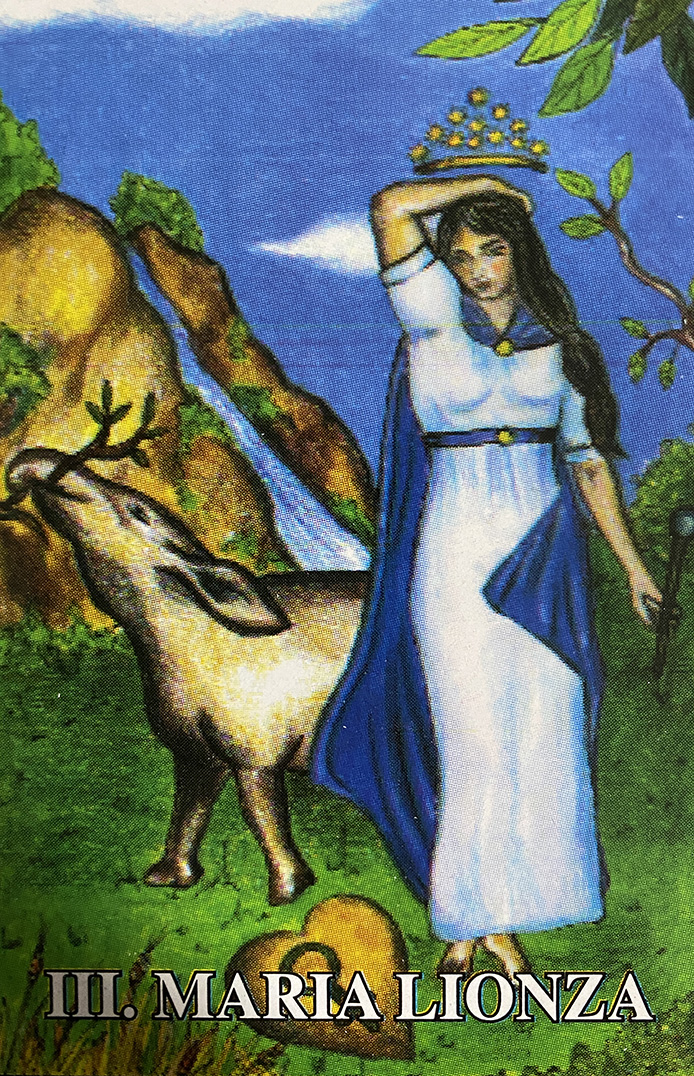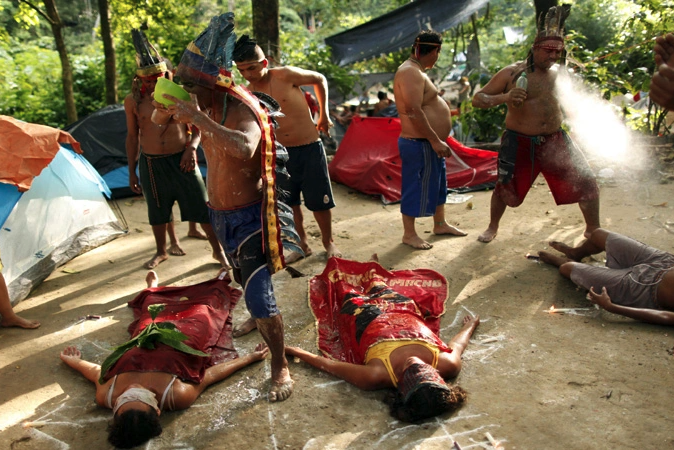Difference between revisions of "María Lionza"
Occultwiki (talk | contribs) (→Cult) |
Occultwiki (talk | contribs) |
||
| Line 20: | Line 20: | ||
==Traditions and spiritism== | ==Traditions and spiritism== | ||
The followers call themselves Marialionceros and refer María Lionza as | The followers call themselves ''Marialionceros'' and refer María Lionza as the "Queen" (Spanish: ''La Reina''). People go to Sorte mountain seeking for strength, healing and to contact the souls of dead people. During the pilgrimage, the principal shamans and priests of María Lionza come together to pay homage. Many followers wear indigenous costumes and perform a traditional fire walking dance called the "dance of hot coals" (Spanish: ''baile de las brasas''). | ||
Several spirits are also worshipped during the rituals alongside Catholic | Several spirits are also worshipped during the rituals alongside Catholic [[saint]]s. María Lionza is one of the main "three powers" (Spanish: ''Tres Potencias''), which also include Guaicaipuro, a legendary indigenous resistance leader of 16th century, and Negro Felipe, a black Afro-American soldier that allegedly participated in the Venezuelan War of Independence. | ||
The lower spirits, usually referred as brothers by the pilgrims, are arranged into 'courts', divided by identity: Indigenous, African, Viking, Liberator. The spirits include farmers, modern criminals and famous historical figures, like Venezuela 19th century liberator Simón Bolívar. Many followers cleanse themselves in the muddy rivers to receive the spirits. [[Shaman]]s take the role of mediums between the pilgrims and the spirits, and usually demand their followers to enter into a trance state which often leads them to speak in tongues or harming themselves. The shamans and the Marialionceros employ blessings, cursing, drum playing, cigar smoking, tobacco chewing, and local liquors during the yearly rituals. Various sources have reported sightings of [[shaman]]s, sometimes wearing horned helmets, claiming to have contacted the legendary Viking Eric the Red, the first Norse explorer to discover Greenland. | |||
Many members from other religions native to Latin America and Venezuela are present, primarily Santeros (a syncretism between African Yoruba beliefs and Catholicism, known for sacrificing animals to pay homage to Orishas) and Paleros (a syncretic Afro-Cuban religion centered on communicating with the dead). | Many members from other religions native to Latin America and Venezuela are present, primarily Santeros (a syncretism between African Yoruba beliefs and Catholicism, known for sacrificing animals to pay homage to Orishas) and Paleros (a syncretic Afro-Cuban religion centered on communicating with the dead). | ||
Revision as of 05:05, 3 October 2023

María Lionza is a folk saint and the central figure in the most widespread new religious movement in Venezuela. The cult of María Lionza is a blend of African, indigenous and Catholic beliefs. She is revered as a goddess of nature, love, peace and harmony. She has followers throughout Venezuelan society, from small rural villages to Caracas, where a monumental statue stands in her honor. The Cerro María Lionza Natural Monument (also known as Sorte mountain) where an important pilgrimage takes place every October, was named after her.
Legend
According to the main legend, María Lionza was born in the 15th–16th century as the daughter of an indigenous chief from the region of Yaracuy. Her father sent her to live in the Sorte mountain. One day, while she was by the river, an anaconda attacked and devoured her. From within the serpent, María Lionza begged the mountain for help. The mountain agreed, María Lionza thus disintegrated and merged with Sorte mountain. Sometimes the anaconda is said to have exploded and caused torrential rains, that are common in the region.
María Lionza is sometimes portrayed as an indigenous woman and sometimes as pale-skinned with green eyes, usually surrounded by animals. She is often depicted naked riding a tapir.
María Lionza is sometimes called Yara, an indigenous alternative name. According to some versions, Yara would have taken the name Santa María de la Onza Talavera del Prato de Nívar or simply Santa María de la Onza ("Saint Mary of the Ounce") under Catholic influence during the Spanish colonization of Venezuela. Subsequently, her name would have been shortened to "María Lionza."
Cult
The rites of María Lionza take place in the Sorte mountain, near the town of Chivacoa in Yaracuy state, Venezuela. The origins of the cult are uncertain, it is a syncretism of Indigenous, Catholic and African beliefs. Traditions of trance communication (seeking to channel the soul of dead people in a living body) may have started about 19th and 20th century in Latin America, popularized by the teachings of the 19th century Frenchman Allan Kardec. Angelina Pollok-Eltz from Andrés Bello Catholic University in Venezuela, who has worked on the subject, says that the rituals in Sorte started in the early 1920s and were brought to urban areas a decade later.
Maria Lionza followers travel to the mountain for a week each October 12 during the national Day of Indigenous Resistance. In 2011, estimates indicated that about 10% to 30% Venezuelan were followers of the cult. At the time, Venezuelan authorities indicated that about 200 thousands followers participated in the traditions, including foreigners coming from the Americas and Europe. In 2011, Wade Glenn, an anthropologist from Tulane University in the United States, estimated that about 60% of Venezuelan population may have participated in the cult of María Lionza at some point. Glenn argues that the conversational aspect of the rituals may have therapeutical effects.
The rituals themselves bear much in common with traditional Haitian Voodoo, although the two religions are not connected. They both involve drinking alcohol, smoking, and trances caused by rhythmic drumming.
Members from all Venezuelan social classes participate in the rituals. In local reports, the rituals have been considered to be linked with the late president of Venezuela Hugo Chávez, yet there is little to no evidence. Chávez himself said he did not take part in it, and some followers of María Lionza have said to support him while others dislike Chávez. Some analysts argue that the decline of political power of the Catholic Church during Chávez, along with the crisis in Venezuela, may have led many Venezuelans to seek for help and join the cult. The hyperinflation in Venezuela that started in 2016 has affected the rituals as many are unable to access the materials necessary to carry out the ceremonies.
Traditions and spiritism
The followers call themselves Marialionceros and refer María Lionza as the "Queen" (Spanish: La Reina). People go to Sorte mountain seeking for strength, healing and to contact the souls of dead people. During the pilgrimage, the principal shamans and priests of María Lionza come together to pay homage. Many followers wear indigenous costumes and perform a traditional fire walking dance called the "dance of hot coals" (Spanish: baile de las brasas).
Several spirits are also worshipped during the rituals alongside Catholic saints. María Lionza is one of the main "three powers" (Spanish: Tres Potencias), which also include Guaicaipuro, a legendary indigenous resistance leader of 16th century, and Negro Felipe, a black Afro-American soldier that allegedly participated in the Venezuelan War of Independence.
The lower spirits, usually referred as brothers by the pilgrims, are arranged into 'courts', divided by identity: Indigenous, African, Viking, Liberator. The spirits include farmers, modern criminals and famous historical figures, like Venezuela 19th century liberator Simón Bolívar. Many followers cleanse themselves in the muddy rivers to receive the spirits. Shamans take the role of mediums between the pilgrims and the spirits, and usually demand their followers to enter into a trance state which often leads them to speak in tongues or harming themselves. The shamans and the Marialionceros employ blessings, cursing, drum playing, cigar smoking, tobacco chewing, and local liquors during the yearly rituals. Various sources have reported sightings of shamans, sometimes wearing horned helmets, claiming to have contacted the legendary Viking Eric the Red, the first Norse explorer to discover Greenland.
Many members from other religions native to Latin America and Venezuela are present, primarily Santeros (a syncretism between African Yoruba beliefs and Catholicism, known for sacrificing animals to pay homage to Orishas) and Paleros (a syncretic Afro-Cuban religion centered on communicating with the dead).
El Tarot de Maria Lionza
In 2004, Venezuelan artist Jose Figueras Diaz created The Tarot of Maria Lionza. The Tarot deck was published by Inversiones Orunmila C.A., Caracas, Venezuela. This deck was little known outside of Venezuela or the Venezuelan expatriate community.
The deck included 78 cards featuring different people from the Maria Lionza legends. It included a robust instructional manual in Spanish.
